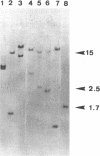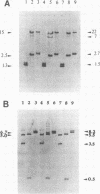Abstract
The Pseudomonas putida TOL plasmid pWW0 is able to mediate chromosomal mobilization in the canonical unidirectional way, i.e., from donor to recipient cells, and bidirectionally, i.e., donor-->recipient-->donor (retrotransfer). Transconjugants are recipient cells that have received DNA from donor cells, whereas retrotransconjugants are donor bacteria that have received DNA from a recipient. The TOL plasmid pWW0 is able to directly mobilize and retromobilize a kanamycin resistance marker integrated into the chromosome of other P. putida strains, a process that appears to involve a single conjugational event. The rate of retrotransfer (as well as of direct transfer) of the chromosomal marker is influenced by the location of the kanamycin marker on the chromosome and ranges from 10(-3) to less than 10(-8) retrotransconjugants per donor (transconjugants per recipient). The mobilized DNA is incorporated into the chromosome of the retrotransconjugants (transconjugants) in a process that seems to occur through recombination of highly homologous flanking regions. No interspecific mobilization of the chromosomal marker in matings involving P. putida and the closely related Pseudomonas fluorescens, which belongs to rRNA group I, was observed.
Full text
PDF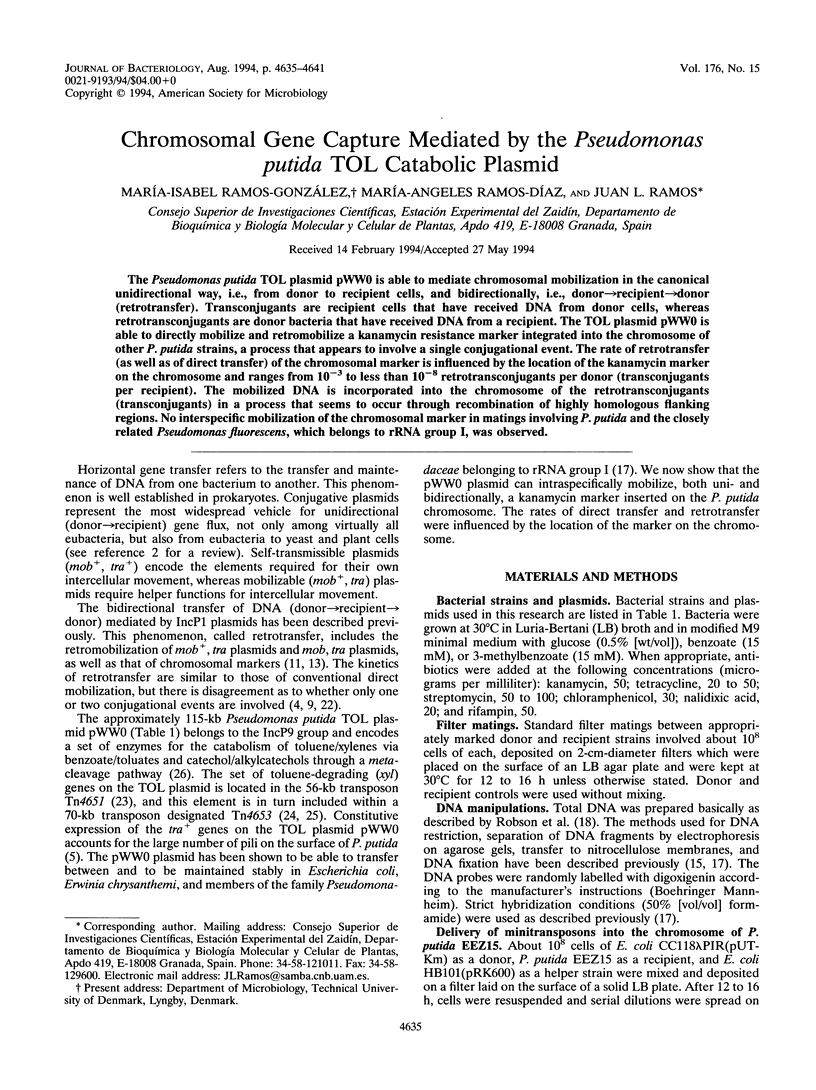

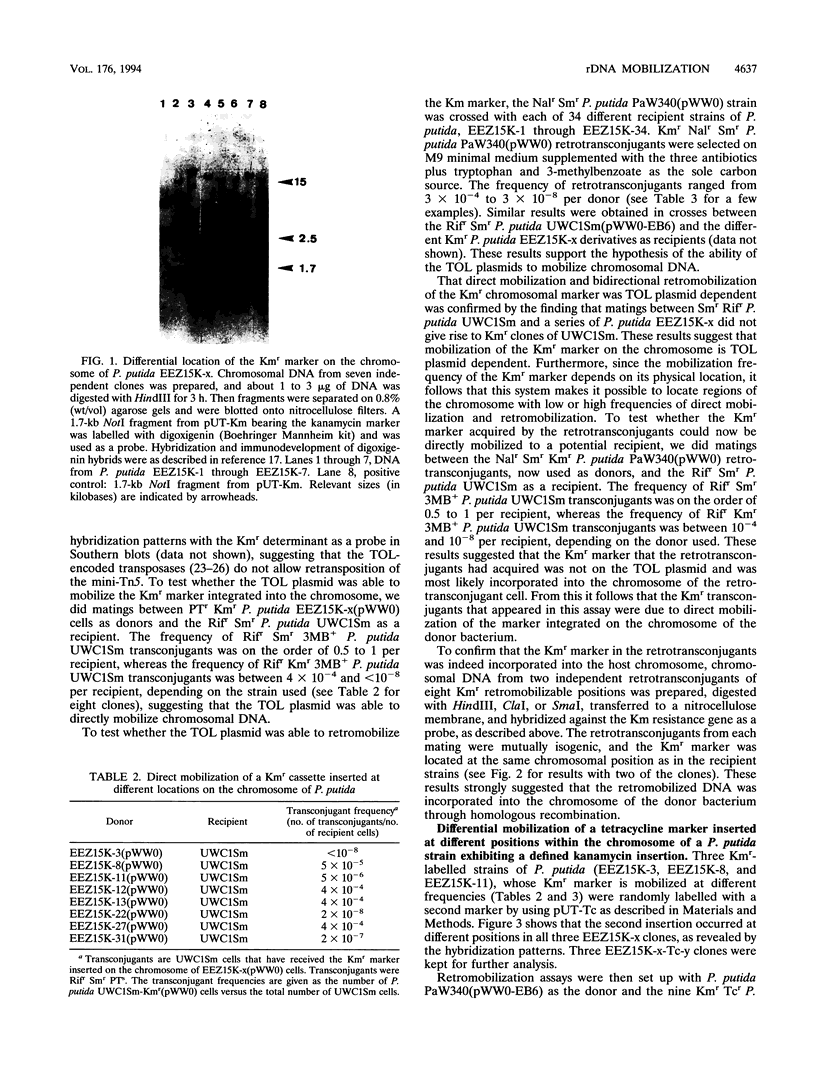
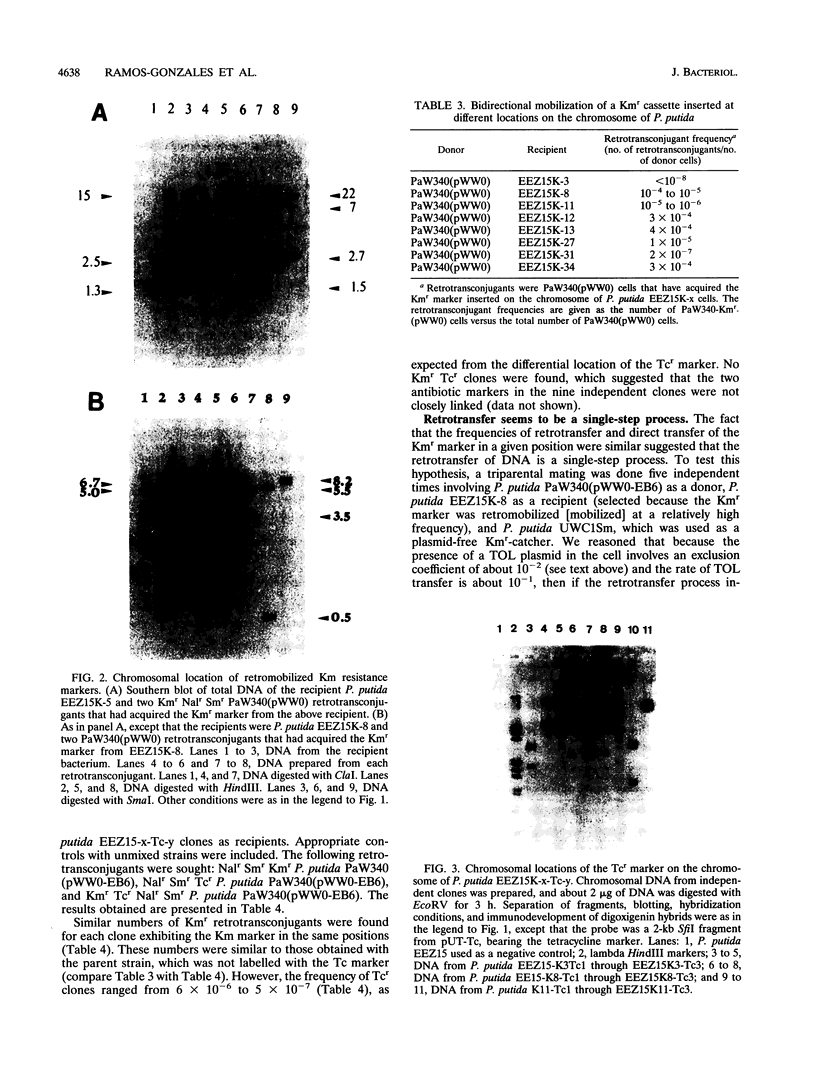



Images in this article
Selected References
These references are in PubMed. This may not be the complete list of references from this article.
- Abril M. A., Michan C., Timmis K. N., Ramos J. L. Regulator and enzyme specificities of the TOL plasmid-encoded upper pathway for degradation of aromatic hydrocarbons and expansion of the substrate range of the pathway. J Bacteriol. 1989 Dec;171(12):6782–6790. doi: 10.1128/jb.171.12.6782-6790.1989. [DOI] [PMC free article] [PubMed] [Google Scholar]
- Amábile-Cuevas C. F., Chicurel M. E. Bacterial plasmids and gene flux. Cell. 1992 Jul 24;70(2):189–199. doi: 10.1016/0092-8674(92)90095-t. [DOI] [PubMed] [Google Scholar]
- Bagdasarian M., Timmis K. N. Host: vector systems for gene cloning in Pseudomonas. Curr Top Microbiol Immunol. 1982;96:47–67. doi: 10.1007/978-3-642-68315-2_4. [DOI] [PubMed] [Google Scholar]
- Bradley D. E., Williams P. A. The TOL plasmid is naturally derepressed for transfer. J Gen Microbiol. 1982 Dec;128(12):3019–3024. doi: 10.1099/00221287-128-12-3019. [DOI] [PubMed] [Google Scholar]
- Campbell A. M. Chromosomal insertion sites for phages and plasmids. J Bacteriol. 1992 Dec;174(23):7495–7499. doi: 10.1128/jb.174.23.7495-7499.1992. [DOI] [PMC free article] [PubMed] [Google Scholar]
- Heinemann J. A., Ankenbauer R. G. Retrotransfer in Escherichia coli conjugation: bidirectional exchange or de novo mating? J Bacteriol. 1993 Feb;175(3):583–588. doi: 10.1128/jb.175.3.583-588.1993. [DOI] [PMC free article] [PubMed] [Google Scholar]
- Herrero M., de Lorenzo V., Timmis K. N. Transposon vectors containing non-antibiotic resistance selection markers for cloning and stable chromosomal insertion of foreign genes in gram-negative bacteria. J Bacteriol. 1990 Nov;172(11):6557–6567. doi: 10.1128/jb.172.11.6557-6567.1990. [DOI] [PMC free article] [PubMed] [Google Scholar]
- Mergeay M., Lejeune P., Sadouk A., Gerits J., Fabry L. Shuttle transfer (or retrotransfer) of chromosomal markers mediated by plasmid pULB113. Mol Gen Genet. 1987 Aug;209(1):61–70. doi: 10.1007/BF00329837. [DOI] [PubMed] [Google Scholar]
- Nakazawa T. TOL plasmid in Pseudomonas aeruginosa PAO: thermosensitivity of self-maintenance and inhibition of host cell growth. J Bacteriol. 1978 Feb;133(2):527–535. doi: 10.1128/jb.133.2.527-535.1978. [DOI] [PMC free article] [PubMed] [Google Scholar]
- Ramos-Gonzalez M. I., Duque E., Ramos J. L. Conjugational transfer of recombinant DNA in cultures and in soils: host range of Pseudomonas putida TOL plasmids. Appl Environ Microbiol. 1991 Oct;57(10):3020–3027. doi: 10.1128/aem.57.10.3020-3027.1991. [DOI] [PMC free article] [PubMed] [Google Scholar]
- Ramos J. L., Stolz A., Reineke W., Timmis K. N. Altered effector specificities in regulators of gene expression: TOL plasmid xylS mutants and their use to engineer expansion of the range of aromatics degraded by bacteria. Proc Natl Acad Sci U S A. 1986 Nov;83(22):8467–8471. doi: 10.1073/pnas.83.22.8467. [DOI] [PMC free article] [PubMed] [Google Scholar]
- Ramos J. L., Wasserfallen A., Rose K., Timmis K. N. Redesigning metabolic routes: manipulation of TOL plasmid pathway for catabolism of alkylbenzoates. Science. 1987 Jan 30;235(4788):593–596. doi: 10.1126/science.3468623. [DOI] [PubMed] [Google Scholar]
- Robson R. L., Chesshyre J. A., Wheeler C., Jones R., Woodley P. R., Postgate J. R. Genome size and complexity in Azotobacter chroococcum. J Gen Microbiol. 1984 Jul;130(7):1603–1612. doi: 10.1099/00221287-130-7-1603. [DOI] [PubMed] [Google Scholar]
- Schultz D. W., Smith G. R. Conservation of Chi cutting activity in terrestrial and marine enteric bacteria. J Mol Biol. 1986 Jun 20;189(4):585–595. doi: 10.1016/0022-2836(86)90489-4. [DOI] [PubMed] [Google Scholar]
- Thomas C. M., Smith C. A. Incompatibility group P plasmids: genetics, evolution, and use in genetic manipulation. Annu Rev Microbiol. 1987;41:77–101. doi: 10.1146/annurev.mi.41.100187.000453. [DOI] [PubMed] [Google Scholar]
- Top E., Vanrolleghem P., Mergeay M., Verstraete W. Determination of the mechanism of retrotransfer by mechanistic mathematical modeling. J Bacteriol. 1992 Sep;174(18):5953–5960. doi: 10.1128/jb.174.18.5953-5960.1992. [DOI] [PMC free article] [PubMed] [Google Scholar]
- Tsuda M., Iino T. Genetic analysis of a transposon carrying toluene degrading genes on a TOL plasmid pWW0. Mol Gen Genet. 1987 Dec;210(2):270–276. doi: 10.1007/BF00325693. [DOI] [PubMed] [Google Scholar]
- Tsuda M., Iino T. Identification and characterization of Tn4653, a transposon covering the toluene transposon Tn4651 on TOL plasmid pWW0. Mol Gen Genet. 1988 Jul;213(1):72–77. doi: 10.1007/BF00333400. [DOI] [PubMed] [Google Scholar]
- Tsuda M., Minegishi K., Iino T. Toluene transposons Tn4651 and Tn4653 are class II transposons. J Bacteriol. 1989 Mar;171(3):1386–1393. doi: 10.1128/jb.171.3.1386-1393.1989. [DOI] [PMC free article] [PubMed] [Google Scholar]
- Worsey M. J., Williams P. A. Metabolism of toluene and xylenes by Pseudomonas (putida (arvilla) mt-2: evidence for a new function of the TOL plasmid. J Bacteriol. 1975 Oct;124(1):7–13. doi: 10.1128/jb.124.1.7-13.1975. [DOI] [PMC free article] [PubMed] [Google Scholar]



